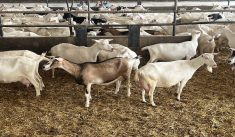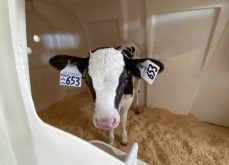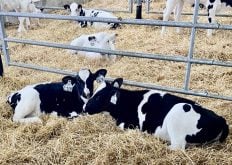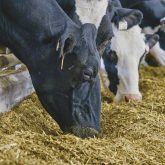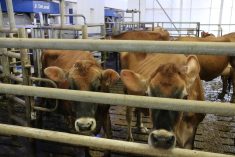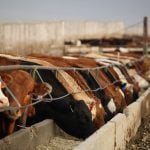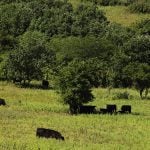Critics say a study claiming Canadian dairy producers waste billions of litres of milk each year is based on incorrect assumptions.
The study co-authored by Sylvain Charlebois from Dalhousie University’s Agri-Food Analytics Lab, Benjamin Goldstein from the University of Michigan and Thomas Elliot from Aalborg University in Denmark, said Canadian producers have wasted between 6.8 billion and 10 billion litres of milk since 2012.
The value of that was estimated at $14.9 billion and the upper estimate would contribute 8.4 million tonnes of carbon dioxide equivalent emissions.
Read Also

Ontario dairy goat producers move toward forming provincial board
Creation of a Dairy Goat Board under the Ontario Farm Products Marketing Commission may be voted on by early 2026.
The Canadian Dairy Commission said the authors came up with these numbers using unverifiable assumptions. One is the number of cows and an assumed amount of production from each to obtain a theoretical production number.
“These production figures do not match industry figures,” the CDC said.
The study said production was 96.2 billion litres between 2012 and 2021, but farmers reported selling 86.4 billion litres. It said some of the milk was likely rejected by processors or discarded by farmers because of food safety rules or lack of on-farm capacity.
The study also acknowledges farmers discard milk for reasons such as low market demand, limited processor capacity, antibiotic residue or damaged farm infrastructure.
The CDC said it is concerned about the assumption that the difference between the authors’ theoretical figure and sales data indicates milk has gone unmarketed.
“It is important to note that, based on verifiable data, of the approximately 9.6 billion litres of milk produced in Canada in the dairy year 2023-24, 99.9 per cent of butterfat and 99.1 per cent of solids non-fat produced in Canadian farms were marketed,” the commission said.
Milk from farms must be collected and delivered for processing within two to three days.
The commission said if all the components of that milk can’t be processed in the province in which it is collected, it could be sent to another province, donated to food banks or fed to calves or other animals.
“A very small proportion of the unmarketed milk components were therefore discarded. This is mainly skimmed milk and not whole milk,” the commission said. “All costs of milk that goes unmarketed are borne by producers. As such, disposing of large volumes of milk on the farm is not financially sustainable.”
The dairy commission also noted investments over the last few years to boost the processing of skim milk in Canada.
Dairy Farmers of Canada issued a short public statement about the study, saying it used estimates rather than robust data. It acknowledged that milk is dumped but only as a last resort and in accordance with regulations.
Provincial associations and individual dairy farmers contacted about the study declined to comment.
The study was published online in Ecological Economics. The authors said they used a mass-balance method to calculate surplus milk amounts.
“We estimated the milk production based on herd size and average milk yield per cow lactation and subtracted the farmgate sales to infer the amount of milk that never left the farm,” the study said.
“We combined these estimates with intensities of GHGs, land use and water use per litre of milk to quantify the environmental costs of surplus milk.”
According to the study, the authors used the national agriculture census to determine the total number of cows and assumed they produce for 305 days each year. It said production statistics are breed specific, and they used data for each breed in each province to estimate total national raw milk production.
They then subtracted the amount calves would consume, assuming one calf per lactation, weaning at eight weeks and no use of milk replacer.
The amount sold to processors was subtracted to infer the amount that didn’t leave the farm.
“Unaccounted milk is assumed to be on-farm discarded milk,” the study said.
The greenhouse gas impact was measured using life cycle inventory data from Quebec, including activities such as fertilizer, feed production, transportation and machinery operation.
The study recommended actions to mitigate milk waste, including mandatory reporting on surplus production, revised dairy quotas to better align with market demand and consumer preferences, and penalties for overproduction rather than underproduction.
It said other countries also have milk waste challenges, and large producers such as the United States, New Zealand and European Union members struggle with the complexity of balancing supply and demand.
Consumers are also changing their behaviour and moving to plant-based “milk,” which suggests a need for a broader conversation about diet and sustainability, the authors added.
“A long-term strategy aligned with these trends would be to sustainably downscale production, without inducing demand or harming farmers in the meantime,” said the study.





